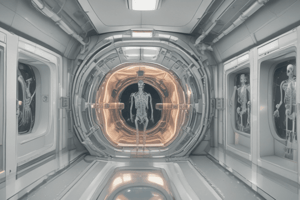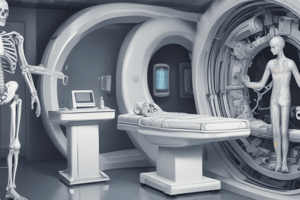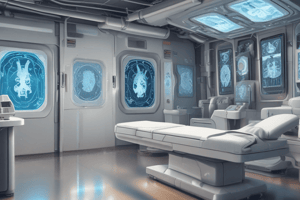Podcast
Questions and Answers
What is the primary purpose of CT scans in medical diagnostics?
What is the primary purpose of CT scans in medical diagnostics?
- To provide basic visualizations of the body without detail
- To replace the need for other imaging modalities like MRI or ultrasound
- To dissect and analyze tissues for laboratory studies
- To offer detailed cross-sectional images for diagnosis and treatment guidance (correct)
What is the role of the computer system in the CT scanning process?
What is the role of the computer system in the CT scanning process?
- To analyze the X-ray profiles and construct viewable images (correct)
- To position the patient accurately within the scanner
- To calibrate the X-ray tube generators before scanning
- To generate the two-dimensional images before adding computer analysis
During a CT scan, how many profiles are typically acquired in one rotation?
During a CT scan, how many profiles are typically acquired in one rotation?
- Around 100
- Approximately 500
- Roughly 1,500
- About 1,000 (correct)
What is the diameter range of the circular opening in a CT scanner?
What is the diameter range of the circular opening in a CT scanner?
What term describes the images generated from two-dimensional X-ray images during CT scans?
What term describes the images generated from two-dimensional X-ray images during CT scans?
Flashcards
CT Scan
CT Scan
A medical imaging technique that uses X-rays to create detailed cross-sectional images of the body's internal structures.
Diagnostic Purposes of CT Scans
Diagnostic Purposes of CT Scans
CT scans can help doctors diagnose various medical conditions, such as cancer, heart disease, and lung nodules.
Guidance for Treatment with CT Scans
Guidance for Treatment with CT Scans
CT scans can be used to guide procedures like biopsies and radiation therapy, ensuring accuracy and precision.
How CT Scans Work
How CT Scans Work
Signup and view all the flashcards
Profiles in CT Scan
Profiles in CT Scan
Signup and view all the flashcards
Study Notes
CT Scan Functionality
- CT scans produce detailed cross-sectional images of internal structures, including organs, blood vessels, bones, and soft tissues.
- Applications include diagnostics, treatment guidance (surgeries, biopsies, radiation therapy), and condition detection/monitoring (e.g., cancer, heart disease, lung nodules, liver masses).
Image Generation
- Digital geometry processing creates a 3D image from a large set of 2D X-ray images taken around a single axis.
- A flat patient table (couch) is positioned in the scanner's circular opening with a diameter of 24-28 inches for patient placement and adjustment.
- The table moves the patient into the gantry, and an X-ray tube rotates around the patient.
- The scanner gantry houses the rotating X-ray tube and detector array.
- A computer system processes measurements, resulting in viewable images.
Image Acquisition
- Each full rotation of the tube results in one cross-sectional slice.
- Numerous profiles (multiple shots) are acquired during a single rotation.
- Typically, around 1,000 profiles are gathered per rotation.
- A complete set of profiles from each rotation is analyzed by a computer to form a two-dimensional image (slice).
Studying That Suits You
Use AI to generate personalized quizzes and flashcards to suit your learning preferences.




